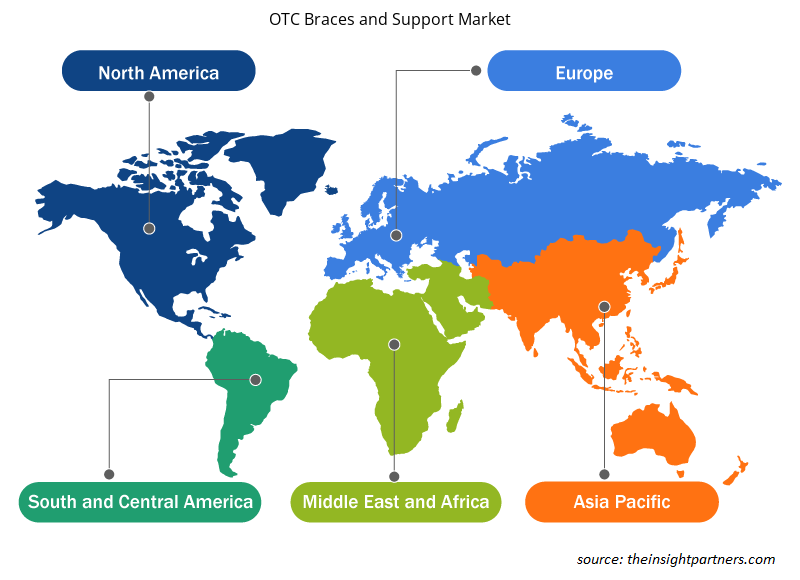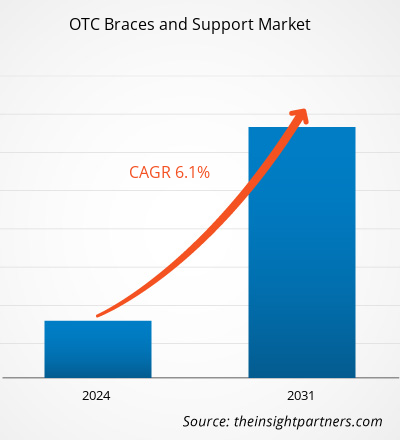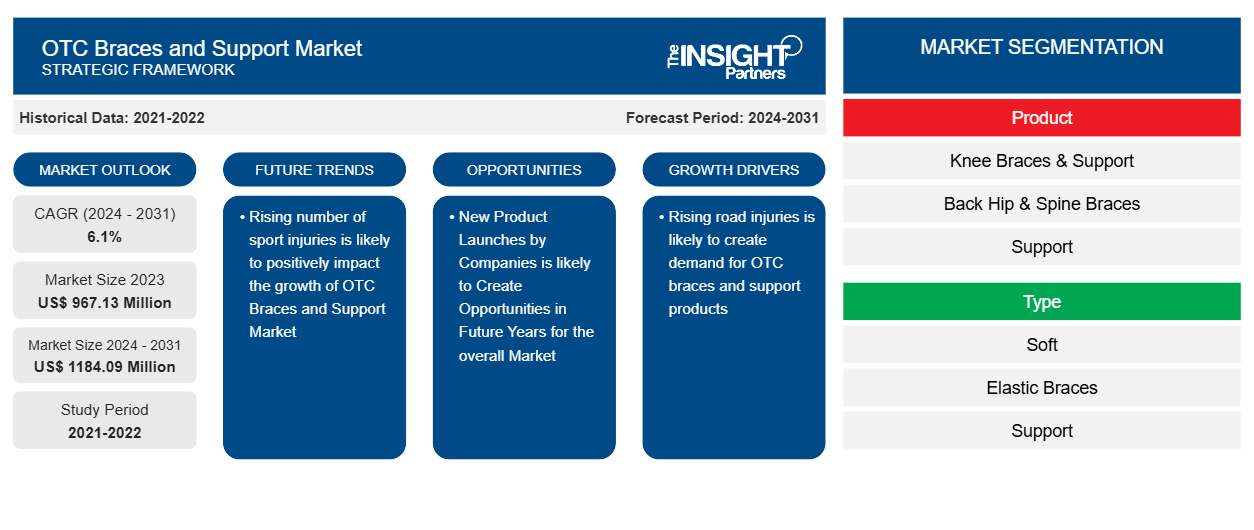Se proyecta que el tamaño del mercado de aparatos ortopédicos y soportes de venta libre alcance los 1184,09 millones de dólares estadounidenses para 2031, frente a los 967,13 millones de dólares estadounidenses en 2023. Se espera que el mercado registre una CAGR del 6,1 % entre 2024 y 2031. Es probable que el aumento de las lesiones en la carretera y la creciente demanda de participación en deportes sigan siendo una tendencia del mercado de aparatos ortopédicos y soportes de venta libre.CAGR of 6.1% in 2024–2031. Rising road injuries and growing demand in sports participation is likely to remain an OTC braces and support market trend.
Análisis del mercado de aparatos ortopédicos y soportes de venta libre
Según el Consejo Nacional de Seguridad, aunque las motocicletas representan hasta el 3% de todos los vehículos registrados y el 0,7% de todos los kilómetros recorridos en vehículos en los Estados Unidos, los motociclistas representaron el 14,6% de todas las muertes por accidentes de tráfico y el 3,5% de todas las lesiones en el año 2022. Un factor común que influye directamente en las tendencias de mortalidad de las motocicletas es el uso del casco. Las muertes entre motociclistas y pasajeros aumentaron un 1% de 2021 a 2022, mientras que la tasa por cada 100 millones de kilómetros recorridos por vehículo disminuyó un 16%. La tasa de mortalidad disminuye en 2022 como resultado de un aumento del 21% en los kilómetros recorridos. En los últimos 10 años, las muertes han aumentado un 32%, mientras que las tasas de mortalidad se han reducido drásticamente en un 13%. El número de muertes por accidentes de tráfico asciende actualmente a 6.218 y la tasa es de 26,16 por cada 100 millones de kilómetros recorridos por vehículo. Según Action Sports EMS, se ha informado de que las lesiones de la columna cervical resultantes de accidentes de motocicleta de cualquier tipo tienen un 82 % más de probabilidades de ocurrir cuando se conduce sin collarín. Por lo tanto, se espera que el creciente número de accidentes de motocicleta impulse el mercado mundial de collarines y soportes de venta sin receta.travelled in the United States, motorcyclists accounted for 14.6% of all traffic fatalities and 3.5% of all injuries in the year 2022. A common factor that directly influences motorcycle mortality trends is helmet use. Fatalities among motorcycle riders and passengers increased by 1% from 2021 to 2022, while the rate per 100 million vehicle miles travelled decreased by 16%. The fatality rate decreases in 2022 is a result of a 21% increase in miles driven. In the last 10 years, deaths have increased by 32%, while death rates have drastically reduced by 13%. The number of motorcycle fatalities presently stands at 6,218 and the rate is 26.16 per 100 million vehicle miles. According to the Action Sports EMS, it has been reported that cervical spine injuries resulting from motorcycle accidents of any kind are 82% more likely to happen when riding without a neck brace. Thus, rising number of motorcycle accidents is expected to drive the global OTC braces and support market.
Descripción general del mercado de aparatos ortopédicos y soportes de venta libre
La creciente prevalencia de trastornos ortopédicos tanto en las economías desarrolladas como en las que están en desarrollo, junto con la creciente demanda de participación deportiva entre los millennials, está impulsando la demanda de aparatos ortopédicos y productos de soporte de venta libre. Sin embargo, la eficacia clínica limitada es uno de los factores que están afectando críticamente el crecimiento del mercado de aparatos ortopédicos y productos de soporte de venta libre.
Personalice este informe según sus necesidades
Obtendrá personalización en cualquier informe, sin cargo, incluidas partes de este informe o análisis a nivel de país, paquete de datos de Excel, así como también grandes ofertas y descuentos para empresas emergentes y universidades.
-
Obtenga las principales tendencias clave del mercado de este informe.Esta muestra GRATUITA incluirá análisis de datos, desde tendencias del mercado hasta estimaciones y pronósticos.
Los medicamentos OTC respaldan los impulsores y las oportunidades del mercado
El creciente número de lesiones deportivas favorece al mercado
Según John Hopkins Medicine, en 2022, había alrededor de 30 millones de niños y adolescentes que participaban en algún tipo de deporte organizado en los EE. UU. y cada año se producen más de 3,5 millones de lesiones. Este tipo de lesiones provocan cierta pérdida de tiempo de participación y es probable que se produzcan lesiones comunes como esguinces y distensiones. Todos los tipos de deporte tienen potencial de producir lesiones, ya sea por el traumatismo del contacto con otros jugadores o por el uso excesivo o indebido de una parte del cuerpo. Los aparatos ortopédicos y soportes de venta libre brindan apoyo específico a áreas vulnerables como las rodillas, los codos, las muñecas y los tobillos, lo que reduce el riesgo de distensiones y esguinces. Por lo tanto, el creciente número de lesiones deportivas en los Estados Unidos está contribuyendo al crecimiento del mercado de aparatos ortopédicos y soportes de venta libre.U.S. , and over 3.5 million injuries occurs each year. These types of injuries cause some loss of time of participation and common injuries such as sprains and strains are likely to occur. All sport types have a potential for injury, whether from the trauma of contact with other players or from overuse or misuse of a body part. The OTC braces and support provide targeted support to vulnerable areas such as the knees, elbows, wrists, and ankles, reducing the risk of strains and sprains. Thus, rising number of
Es probable que el lanzamiento de nuevos productos impulse el mercado de aparatos de venta libre y respalde el crecimiento del mercado
En marzo de 2021, la empresa GSK Consumer lanzó una rodillera mejorada digitalmente conocida como VoltActive después de una campaña de marketing de un año a través de enfoques tradicionales y medios digitales. El producto se puede comprar exclusivamente en Amazon. A medida que las personas se involucran más para mantenerse activas y hacer ejercicio, productos como VoltActive ayudan a aliviar el dolor, restaurar el movimiento y reducir la inflamación. Este factor es responsable del crecimiento del tamaño del mercado de aparatos ortopédicos y soportes de venta sin receta.GSK Consumer company launched a digitally enhanced VoltActive after a yearlong marketing campaign via traditional approaches and digital media. The product can be bought exclusively on Amazon. As people engages more to stay active and exercise, products such as VoltActive helps in relieving pain, restore movement, and reduces inflammation. Such a factor is responsible for the growth of the OTC braces and support market size.
Análisis de segmentación del informe de mercado de aparatos ortopédicos y soportes de venta libre
Los segmentos clave que contribuyeron a la derivación del análisis del mercado de aparatos ortopédicos y soportes de venta libre son la aplicación y el usuario final.
- Según la aplicación, el mercado de aparatos ortopédicos y soportes de venta libre se ha segmentado en reparación de lesiones de ligamentos, atención preventiva, osteoartritis, terapia de compresión y otras aplicaciones. El segmento de atención preventiva tuvo la mayor participación del mercado en 2023; es probable que el mismo segmento siga una tendencia similar en el mercado durante el período de pronóstico.
- Según el usuario final, el mercado de aparatos ortopédicos y soportes de venta libre se ha segmentado en hospitales, centros quirúrgicos ambulatorios, clínicas especializadas y otros. El segmento hospitalario tuvo la mayor participación del mercado en 2023. Sin embargo, se estima que las clínicas especializadas registrarán la CAGR más alta del mercado durante el período de pronóstico.CAGR in the market during the forecast period.
Análisis de la cuota de mercado de aparatos ortopédicos y soportes de venta libre por geografía
El alcance geográfico del informe del mercado de aparatos ortopédicos y soportes de venta libre está segmentado principalmente en cinco regiones: América del Norte, Asia Pacífico, Europa, Medio Oriente y África, y América del Sur/América del Sur y Central.
Según la geografía, el mercado de aparatos ortopédicos y soportes de venta libre está segmentado en cinco regiones clave: América del Norte, Europa, Asia Pacífico, América del Sur y Central, y Oriente Medio y África. El mercado de aparatos ortopédicos y soportes de venta libre de América del Norte se ha analizado en función de tres países principales: Estados Unidos, Canadá y México. Se estima que el mercado de aparatos ortopédicos y soportes de venta libre de Estados Unidos tendrá la mayor participación de mercado durante el período de pronóstico. La comercialización de nuevos dispositivos ortopédicos, los escenarios de reembolso favorables y la creciente participación en actividades deportivas por parte de los millennials son algunos de los factores que ayudan al crecimiento del mercado de aparatos ortopédicos y soportes de venta libre en la región de Estados Unidos.
Perspectivas regionales sobre el mercado de aparatos ortopédicos y soporte de venta libre
Los analistas de Insight Partners explicaron en detalle las tendencias y los factores regionales que influyen en el mercado de aparatos ortopédicos y soportes de venta libre durante el período de pronóstico. Esta sección también analiza los segmentos y la geografía del mercado de aparatos ortopédicos y soportes de venta libre en América del Norte, Europa, Asia Pacífico, Oriente Medio y África, y América del Sur y Central.

- Obtenga datos regionales específicos para el mercado de aparatos ortopédicos y soportes de venta libre
Alcance del informe sobre el mercado de aparatos ortopédicos y soportes de venta libre
| Atributo del informe | Detalles |
|---|---|
| Tamaño del mercado en 2023 | US$ 967,13 millones |
| Tamaño del mercado en 2031 | US$ 1184,09 millones |
| CAGR global (2024 - 2031) | 6,1% |
| Datos históricos | 2021-2022 |
| Período de pronóstico | 2024-2031 |
| Segmentos cubiertos |
Por producto
|
| Regiones y países cubiertos |
América del norte
|
| Líderes del mercado y perfiles de empresas clave |
|
Densidad de actores del mercado: comprensión de su impacto en la dinámica empresarial
El mercado de aparatos ortopédicos y soportes de venta libre está creciendo rápidamente, impulsado por la creciente demanda de los usuarios finales debido a factores como la evolución de las preferencias de los consumidores, los avances tecnológicos y una mayor conciencia de los beneficios del producto. A medida que aumenta la demanda, las empresas amplían sus ofertas, innovan para satisfacer las necesidades de los consumidores y aprovechan las tendencias emergentes, lo que impulsa aún más el crecimiento del mercado.
La densidad de actores del mercado se refiere a la distribución de las empresas o firmas que operan dentro de un mercado o industria en particular. Indica cuántos competidores (actores del mercado) están presentes en un espacio de mercado determinado en relación con su tamaño o valor total de mercado.
Las principales empresas que operan en el mercado de aparatos ortopédicos y soportes de venta libre son:
- Compañía 3M
- DJO Global, Inc.
- Pájaro y Cronin
- Esencia
- Zimmer Biomet Holdings, Inc
- Aparato ortopédico de venta libre
Descargo de responsabilidad : Las empresas enumeradas anteriormente no están clasificadas en ningún orden particular.

- Obtenga una descripción general de los principales actores clave del mercado de aparatos ortopédicos y soportes OTC
Noticias del mercado y desarrollos recientes sobre soporte y soporte de OTC
El mercado de aparatos ortopédicos y soportes de venta libre se evalúa mediante la recopilación de datos cualitativos y cuantitativos posteriores a la investigación primaria y secundaria, que incluye publicaciones corporativas importantes, datos de asociaciones y bases de datos. A continuación, se incluye una lista de los avances en el mercado en materia de innovaciones, expansión comercial y estrategias:
- En julio de 2023, OS1st lanzó su rodillera de alto rendimiento KS8 que ayuda a estabilizar la articulación de la rodilla durante el proceso de curación de una cirugía de rodilla o un dolor articular persistente. El producto cuenta con un anillo rotuliano liviano y varillas removibles con una combinación ultra suave de materiales de micro-nailon y LYCRA Spandex y agarres de gel de silicona hipoalergénicos antideslizantes para reducir el deslizamiento y permitir un uso continuo. (Fuente: OS1st., Blogs)
Informe sobre el mercado de aparatos ortopédicos y soportes de venta libre: cobertura y resultados
El informe “Tamaño y pronóstico del mercado de aparatos ortopédicos y soportes de venta libre (2021-2031)” proporciona un análisis detallado del mercado que cubre las siguientes áreas:
- Tamaño del mercado de aparatos ortopédicos y soportes de venta libre y pronóstico a nivel global, regional y nacional para todos los segmentos clave del mercado cubiertos bajo el alcance
- Dinámica del mercado, como impulsores, restricciones y oportunidades clave
- Tendencias del mercado de aparatos ortopédicos y soportes de venta libre
- Análisis detallado de las cinco fuerzas de Porter y PEST y FODA
- Análisis del mercado de aparatos ortopédicos y soportes de venta libre que abarca las tendencias clave del mercado, el marco global y regional, los principales actores, las regulaciones y los desarrollos recientes del mercado
- Panorama de la industria de aparatos ortopédicos y soportes de venta libre y análisis de la competencia que abarca la concentración del mercado, análisis de mapas de calor, actores destacados y desarrollos recientes
- Perfiles detallados de empresas
- Análisis histórico (2 años), año base, pronóstico (7 años) con CAGR
- Análisis PEST y FODA
- Tamaño del mercado, valor/volumen: global, regional y nacional
- Industria y panorama competitivo
- Conjunto de datos de Excel
Informes recientes
Testimonios
Razón para comprar
- Toma de decisiones informada
- Comprensión de la dinámica del mercado
- Análisis competitivo
- Información sobre clientes
- Pronósticos del mercado
- Mitigación de riesgos
- Planificación estratégica
- Justificación de la inversión
- Identificación de mercados emergentes
- Mejora de las estrategias de marketing
- Impulso de la eficiencia operativa
- Alineación con las tendencias regulatorias























 Obtenga una muestra gratuita para - Los aparatos de venta libre y el mercado de apoyo
Obtenga una muestra gratuita para - Los aparatos de venta libre y el mercado de apoyo